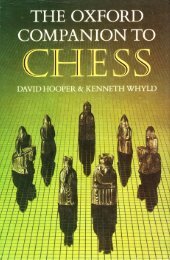Create successful ePaper yourself
Turn your PDF publications into a flip-book with our unique Google optimized e-Paper software.
18 ATKINSON VARIATION<br />
N.4 7Bxc7Qxe? 3Nxe4dxe4 9Nd2f5 10Be2G0 ll<br />
(r0e5 12d5Rl6 Ba3ral6 14s3Os5 15Ob3Rh3 16<br />
Ks2 Qh6 1? Rh1 Nl6 13 Oc2 Bd7 l9 Kgl f4 20 cxf4<br />
cxta 2r Nxea Nka 2 QIea<br />
,.?&AW rur<br />
in<strong>to</strong> @mmon usage !o denole a coward or<br />
AUSTRIAN ArTAClq 6?9, one ol the 6osr<br />
PoPular v.riadom lor White vhen he plays againsl<br />
the FRC-RoBAECE sysEM. Known since the gane<br />
Tarrasch-Charouek, Nurembers 1896, this iine<br />
was developed <strong>by</strong> the Vienrese playes Ha.s<br />
Mnler (189G1971) and DncrcrEN.<br />
AUSTRTAN ITEFENCE. 34. in rhe ouEN's cAMBn<br />
Declined, $nelines called the Symmelrical De-<br />
{eoe. Slenming frcm sAlvro, it was studied <strong>by</strong> the<br />
Aust.ians Haberditz, E.trst cRtNrErD, and Hans<br />
Mnller (189G1971).<br />
22...Re3 23OBfigl 2,lt\s3Ob6+ 25c5 Ox.s+ 26<br />
QD Ord5 27RdlQc6 23BBBC6 29 Bxc6 Qrc6 30<br />
Rrr ad7 3r Qia7b6 r2Qb7Rh6 IOaRfrt 34Ob3+<br />
Kn3 35R 6 gxf6 36OAOd2 White rcsisD.<br />
AI(INSON VARTATION, 309, interesting b!1<br />
usoutrd line played <strong>by</strong> Walre. Alkitr$n 086G<br />
1939) oi Hull; ii was abandoded afier one<br />
appeara.@ in naster play (Vergani Blackbume,<br />
ATTACK, (1) an active threat. Its propo.tion may<br />
ranAe f.om a sinAle move <strong>to</strong> a sustained assa t on<br />
the o.emy ti,goro. sme other targel laling lor<br />
mosl of the gane. Artacks of short dualion arc<br />
usually c.Iled curs and they Gor ireque.tly in<br />
all games. Altacks of longer duration, ofien<br />
localized o. a dank or i. the cenlr€, a.e not<br />
neessanly taclical throughout. A player may<br />
pause 10 safeguard some pan oI his positiotr, io<br />
prevont@urteratt.cta and there are $me artacks,<br />
e.g. the MNow AflacR, which may be carricd ont<br />
<strong>by</strong> means of seemitrgly quiet tutrenvres.<br />
AITACT, (2) a term for an openi.a varia(on<br />
idtiated <strong>by</strong> white. (compare DEFENcE (2).)<br />
ArwOOD, GEORGE 074G1807), dislinguished<br />
English nathematician whose pupil William Pitt<br />
rhe YounSe. rewarded hin with lhe post of Patcnt<br />
Searcher ofthe Cus<strong>to</strong>ms- He played nany games<br />
with PEiL'@R, including th€ ldt lhal the French<br />
man played, aDd .emrded lhe moles of maf,y<br />
Sames <strong>by</strong> Philidor and orher players ai a time when<br />
this {6 nol otheNie done: these manusdipl<br />
sores eve.tMlly reached Georgc wALGRi who<br />
published lheE. Arsood also ptayed agai.sl<br />
vERDoNr in 17%. ln siene he is renenbered for<br />
th€ Atwood apparatu, which demonstrates certain<br />
characte.isliB of lhe las of grality.<br />
AUEIN. a middlc-English rerm lor rhe bishop\<br />
aoces<strong>to</strong>r. the ^LFrL<br />
or PiL. a 2.2. (V8) LEApFB.<br />
Becaus contemporary players were ofietr catrghl<br />
ont <strong>by</strong> the lcap of this weak piece the 1em passed<br />
AUTOMATON, a machine that appeaa lo Play<br />
che$. <strong>The</strong> ongi.al and most laoous, the ruix.<br />
u.veiled in 1769, rd also lhc li.st great cabinei<br />
illusion and there<strong>to</strong>ro of importmce <strong>to</strong> the his<strong>to</strong>ry<br />
ofnagic, As with ils sucesoB, the nosr tanous<br />
being {EEB and MEpHsrc, the exhibi<strong>to</strong>r demonn<br />
r.ated thal no one could be @n.ealed inside the<br />
human looking tgu.o. After being clo*d trp th€<br />
nachin. mored the chesnetr *hen it Played<br />
membes ol lhe Public.<br />
<strong>The</strong> only genuine che$ playing machinc made<br />
before the eleclronic agc, 6rst shown al the end ol<br />
the l9th entury and still in porking order, is<br />
hoNed tu ihe Polytehnic Museum in Madrid.<br />
Much ot rhe worl of its invcn<strong>to</strong>r L.onardo Torrcs y<br />
Ouevedo (1852-1936) w6 subsidized <strong>by</strong> the Spanish<br />
Cove.nnent. (His di.i6b1e, lhe Astra Tores,<br />
was used <strong>by</strong> France durinstne Fist World War.)<br />
His ciess playing machine is reslricled <strong>to</strong> ihe<br />
endgame kirg atrd rook vesus ldng, nor becaue<br />
the Spanish word for rook is <strong>to</strong>ne. but becaue<br />
eracl rules for the winning proccdure are tnown.<br />
<strong>The</strong> machine always takes White and is switched o.<br />
when Black moves his king. Tbe best move is<br />
calolated <strong>by</strong> a pemanent progran and the<br />
machine phlsiely noles a pie@ before switchi.g<br />
off. Larer Tores added a sond lrack which said<br />
' o quhrc juEat tui!, t desprc.,,'(I don t wish ro<br />
play turtier, I scom you) iI an opponenr made an<br />
ilegal nole for the third limc . ioque al rcr' N\e.<br />
giving check, and 'aare' at the end. <strong>The</strong> nachi.e<br />
rhe. ptrts the pieces on rhen srarting squares and<br />
verbaly offeb <strong>to</strong> play again,<br />
Bradloy Ewarr. Ches: Man vs. Machine (San<br />
Diego, 1980).<br />
AtIw. se<br />
^r<br />
r rMw^Nn, 'N.;<br />
AUXILIARY SCORING METEODS, wa'B of<br />
deciding <strong>to</strong>umanent placinSs other lhan <strong>by</strong> means<br />
oI the nomal s@rins (wjns 1, draws 1,losses 0) and<br />
commo.ly known as tie-breaki.g methods frcm<br />
thei. nore rece.t usage. Originally they were<br />
intended <strong>to</strong> supplanl the notual sore <strong>to</strong>r aI<br />
pumoses. <strong>The</strong> basic principle is that wins aeainsl<br />
high{corers should be valued ahove wins agai,sl<br />
back na.kers. (Few thought that loses might have<br />
a sinilar hierarchy.) <strong>The</strong> fr6i dctrmented pro-




